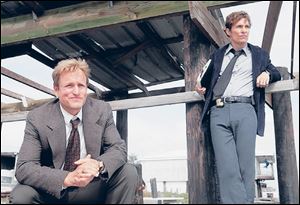
ENTERTAINMENT
‘True Detective’: Seeking a killer and a benign universe
3/11/2014
Woody Harrelson and Matthew McConaughey in a scene from the series ‘True Detective.’
As is so often the case on crime shows, the two partners in True Detective followed a hunch and went straight into the killer’s lair on their own, without backup. They had each other’s backs.
The HBO series True Detective ended its first season Sunday with at least one mystery cleared up: This moody, self-consciously wordy and obscurantist thriller was at heart a buddy act, somewhere between The French Connection and Lethal Weapon 4.
Behind all the Spanish moss, devil worship, and ontological mystique that the show’s creator, Nic Pizzolatto, brought to the script, the eight-part series focused on the on-again, off-again bromance of Marty Hart (Woody Harrelson) and Rust Cohle (Matthew McConaughey).
And that’s what made the series so polarizing. Many loved the lavish, tender attention to the clashing sensibilities — and declamations — of two drawling Southern archetypes. (It helped that the actors were so good.) Others were preoccupied by what went missing on True Detective.
The final episode found time for one last cosmic — and comic — miscommunication between partners. As they drove through a bleak, rundown Louisiana landscape, Cohle cryptically referred to “sentient meat” and once again lectured his partner on the meaninglessness of life. “However illusory our identities are, we craft those identities by making value judgments. Everybody judges, all the time. Now, you got a problem with that, you’re living wrong.”
Hart has only one question: “What’s scented meat?”
Women were peripheral; even Hart’s wife, Maggie, so touchingly played by Michelle Monaghan, was a sad-eyed plot device to drive a wedge between the two men.
Through the clever shuffling of flashbacks and dueling soliloquies, True Detective deciphered its heroes, not their case. Marty was so unmoored by the suffering of children that he quit the police force after finding a baby’s remains in a microwave. But the show never took a second look at the victims, who remained sketchy and unmourned throughout, just discarded bodies, ill used in life and death. (Viewers did hear the pained screams of men watching a snuff film of a little girl kidnapped by Satanists in animal masks.)
And the killer turned out to be almost a parody of a horror movie psycho-deviant: Errol (Glenn Fleshler), a chortling serial killer who went unseen for most of the series and then did a sudden star turn at the end, switching to an upper-crust, Anthony Hopkins-like accent when he saw Cary Grant on his television set. There was also a touch of Anthony Perkins in the way he talked to his decomposing dead father chained to a bed. Mostly, though, in his derelict wreck of a house, overflowing with garbage, dirty pots and antique dolls, the killer, his feebleminded woman and their mangy dog called to mind characters in a George Booth cartoon in The New Yorker.
The story ended, but HBO expects a second season with new characters. In this one, it wasn’t whodunit that mattered, but how the heroes reunited to find him. And for once, it was Hart who intuited the critical clue (green paint) that unmasked the killer.
The detectives got their man; the audience got something else.
Viewers were like the two outside detectives, Gilbough (Michael Potts) and Papania (Tory Kittles), trying to make sense of Cohle’s and Hart’s accounts and feeling confused, spellbound and sometimes just annoyed. In the end, Gilbough and Papania were belatedly brought in on the collar, but were never privy to what really went on.
A suspected pedophile preacher, the Rev. Billy Lee Tuttle (Jay O. Sanders), who had blustered across the narrative like a classic perp on “Law & Order: SVU,” faded out of the story. He wasn’t the serial killer, after all, though he was part of a shadowy satanic cult. Tuttle’s death wasn’t shown or fully explained, and neither was the conspiracy of well-connected locals who protected their child-molesting kin.
Instead, Cohle got an answer to his bleakest existential questions. After all his declarations about the futility of consciousness, he came close to dying and saw the light by surrendering to the dark.
“I could feel my definitions fading,” he shakily told Hart. “Beneath that darkness there was another kind, it was deeper, warm, like a substance. I could feel, man, and I knew, I knew my daughter waited for me there.”
Cohle, whose child had died in a car accident years before, went on to explain that he also felt the presence of his father. “It was like I was a part of everything I ever loved, and we were all, the three of us, just fading out. And all I had to do was let go, and I did. I said, ‘Darkness, yeah.’ And I disappeared. But I could still feel her love there.” Everything, Cohle said in the last scene, comes down to the conflict between light and dark, and he concluded, “The light’s winning.”
Cohle found meaning in life by almost dying. Hart discovered new purpose through friendship — sealed with the gift of Camel cigarettes. The show is called “True Detective,” but at the end it was true love that prevailed.